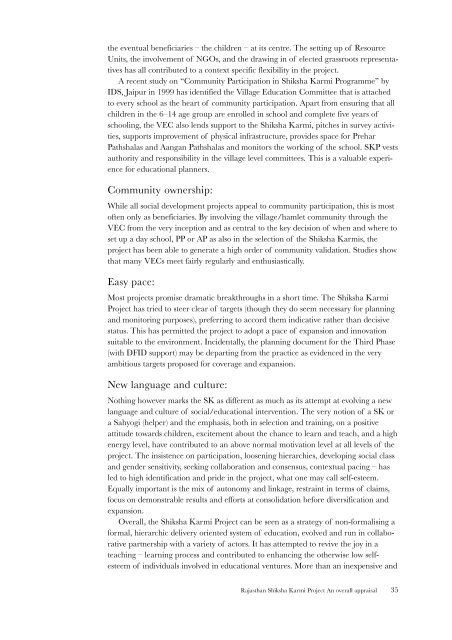Rajasthan Shiksha Karmi Project An overall appraisal
Rajasthan Shiksha Karmi Project An overall appraisal
Rajasthan Shiksha Karmi Project An overall appraisal
You also want an ePaper? Increase the reach of your titles
YUMPU automatically turns print PDFs into web optimized ePapers that Google loves.
the eventual beneficiaries – the children – at its centre. The setting up of ResourceUnits, the involvement of NGOs, and the drawing in of elected grassroots representativeshas all contributed to a context specific flexibility in the project.A recent study on “Community Participation in <strong>Shiksha</strong> <strong>Karmi</strong> Programme” byIDS, Jaipur in 1999 has identified the Village Education Committee that is attachedto every school as the heart of community participation. Apart from ensuring that allchildren in the 6–14 age group are enrolled in school and complete five years ofschooling, the VEC also lends support to the <strong>Shiksha</strong> <strong>Karmi</strong>, pitches in survey activities,supports improvement of physical infrastructure, provides space for PreharPathshalas and Aangan Pathshalas and monitors the working of the school. SKP vestsauthority and responsibility in the village level committees. This is a valuable experiencefor educational planners.Community ownership:While all social development projects appeal to community participation, this is mostoften only as beneficiaries. By involving the village/hamlet community through theVEC from the very inception and as central to the key decision of when and where toset up a day school, PP or AP as also in the selection of the <strong>Shiksha</strong> <strong>Karmi</strong>s, theproject has been able to generate a high order of community validation. Studies showthat many VECs meet fairly regularly and enthusiastically.Easy pace:Most projects promise dramatic breakthroughs in a short time. The <strong>Shiksha</strong> <strong>Karmi</strong><strong>Project</strong> has tried to steer clear of targets (though they do seem necessary for planningand monitoring purposes), preferring to accord them indicative rather than decisivestatus. This has permitted the project to adopt a pace of expansion and innovationsuitable to the environment. Incidentally, the planning document for the Third Phase(with DFID support) may be departing from the practice as evidenced in the veryambitious targets proposed for coverage and expansion.New language and culture:Nothing however marks the SK as different as much as its attempt at evolving a newlanguage and culture of social/educational intervention. The very notion of a SK ora Sahyogi (helper) and the emphasis, both in selection and training, on a positiveattitude towards children, excitement about the chance to learn and teach, and a highenergy level, have contributed to an above normal motivation level at all levels of theproject. The insistence on participation, loosening hierarchies, developing social classand gender sensitivity, seeking collaboration and consensus, contextual pacing – hasled to high identification and pride in the project, what one may call self-esteem.Equally important is the mix of autonomy and linkage, restraint in terms of claims,focus on demonstrable results and efforts at consolidation before diversification andexpansion.Overall, the <strong>Shiksha</strong> <strong>Karmi</strong> <strong>Project</strong> can be seen as a strategy of non-formalising aformal, hierarchic delivery oriented system of education, evolved and run in collaborativepartnership with a variety of actors. It has attempted to revive the joy in ateaching – learning process and contributed to enhancing the otherwise low selfesteemof individuals involved in educational ventures. More than an inexpensive and<strong>Rajasthan</strong> <strong>Shiksha</strong> <strong>Karmi</strong> <strong>Project</strong> <strong>An</strong> <strong>overall</strong> <strong>appraisal</strong>35












